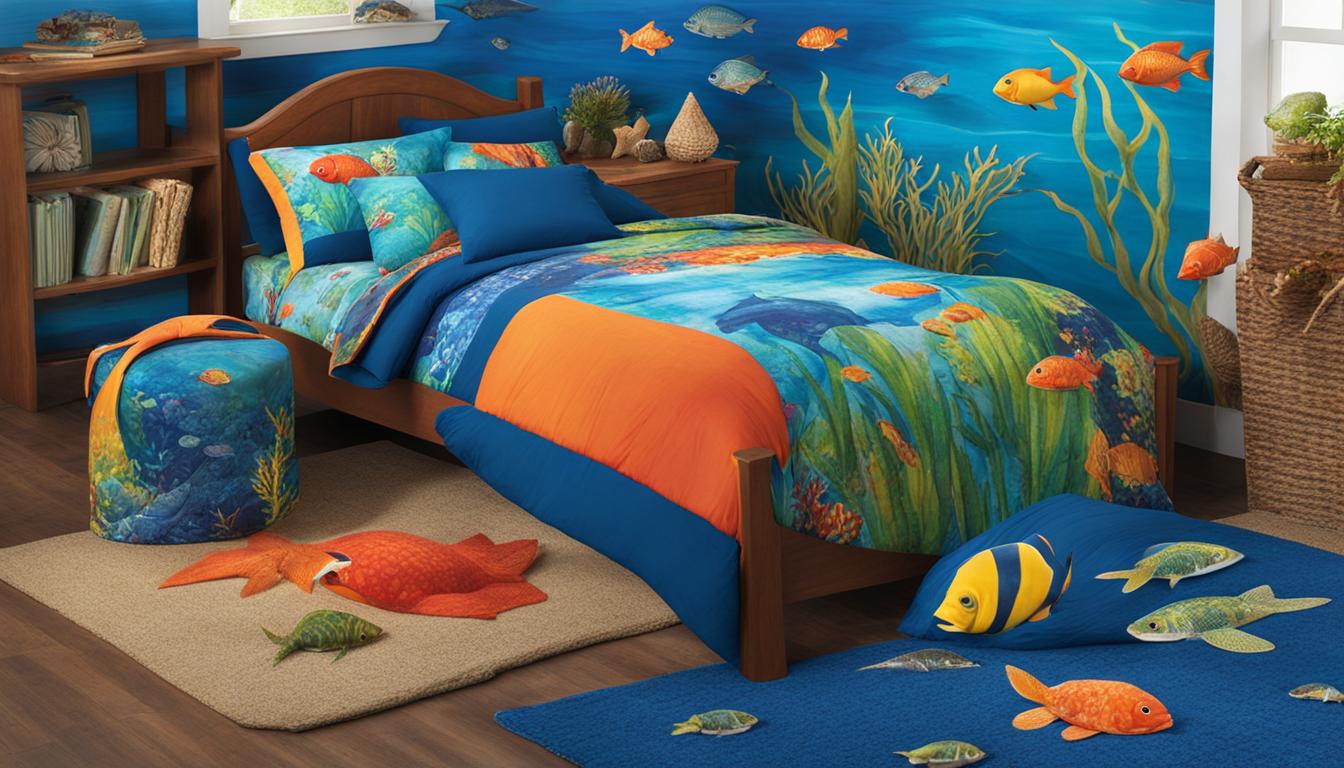Environmental Education Kids Bedding: Teach Sustainability While They Sleep!
Environmental Education Kids Bedding: Transform Bedtime into a Green Learning Adventure!
Teaching children about sustainability and environmental responsibility can start with their bedding choices. By using eco-friendly, organic bedding made from sustainable materials, kids can learn about the importance of caring for the environment while they sleep. With a wide range of options available, parents can find bedding that fosters environmental education and promotes a greener lifestyle for their children.
Key Takeaways:
- Eco-friendly bedding for kids is made from sustainable materials, promoting environmental consciousness
- Choosing organic bedding provides a healthier and sustainable sleep solution for children
- Bedtime routines can be used as an opportunity to teach children about sustainability
- Selecting sustainable materials for bedding reduces the environmental impact
- Creating eco-friendly bedrooms with plants and energy-efficient lighting contributes to a greener sleep environment
The Benefits of Eco-Friendly Bedding for Kids

Eco-friendly bedding for kids offers numerous benefits. It is made from sustainable materials, such as organic cotton, linen, bamboo, or eucalyptus, which have a lower environmental impact compared to conventional bedding materials. These materials are often free from harmful chemicals and are biodegradable, making them a healthier and more sustainable choice for children. Additionally, eco-friendly bedding options come in a variety of styles and designs, allowing parents to find bedding that is both environmentally conscious and appealing to their children.
By choosing eco-friendly bedding for your kids, you are not only providing them with a comfortable and cozy sleep environment, but you are also teaching them about the importance of caring for the planet. Sustainable bedding options allow children to learn firsthand about eco-consciousness and make environmentally friendly choices. They can feel proud knowing that their bedding is made from eco-friendly materials that have a positive impact on the environment.
Furthermore, eco-friendly bedding options are often crafted with high-quality and durable materials, ensuring that they can withstand the wear and tear of children’s daily activities. This means that you won’t have to frequently replace their bedding, reducing waste and saving money in the long run.
The Environmental Impact Comparison Table
| Bedding Material | Environmental Impact |
|---|---|
| Conventional Bedding (e.g., polyester) | High production carbon emissions, non-biodegradable, toxic chemicals |
| Eco-Friendly Bedding (e.g., organic cotton) | Lower carbon emissions, biodegradable, no harmful chemicals |
| Eco-Friendly Bedding (e.g., bamboo) | Rapidly renewable, biodegradable, water-efficient |
| Eco-Friendly Bedding (e.g., eucalyptus) | Low water and pesticide use, biodegradable, no harmful chemicals |
As you can see from the comparison table, eco-friendly bedding options have a significantly lower environmental impact compared to conventional bedding materials. These sustainable choices help reduce carbon emissions, protect natural resources, and promote a healthier planet for future generations.
By providing your children with eco-friendly bedding, you are not only creating a safe and comfortable sleep environment but also instilling in them the values of sustainability and environmental responsibility. It’s a small step toward a greener future that can make a big difference.
Teaching Sustainability Through Bedtime Routines

Bedtime routines present a unique opportunity to instill principles of environmental education and sustainability in children. By engaging them in eco-conscious practices during their nightly rituals, parents can cultivate an understanding of the importance of reducing waste, conserving resources, and making environmentally friendly choices.
One way to incorporate sustainability into bedtime routines is by involving children in sorting recyclables. Teach them the significance of recycling and the positive impact it has on the environment. Create a designated area where they can separate items like paper, plastic, and glass, fostering a habit of responsible waste management.
Mindful grocery shopping can also be a part of the evening routine. Encourage children to join you in selecting products with minimal packaging or opting for eco-friendly alternatives. Explain the benefits of choosing locally sourced, organic, or sustainably produced options, helping them understand the importance of making environmentally conscious food choices.
Furthermore, using natural and eco-friendly cleaning products during the bedtime routine can reinforce sustainable practices. Involve children in the cleaning process and demonstrate how these products are safer for the environment and their health. Explain how avoiding harmful chemicals can reduce pollution and contribute to a healthier planet.
“Incorporating sustainable habits into bedtime routines offers a unique opportunity to teach children about the impact of their actions on the environment.” – First source
During this time, parents can also discuss the benefits of using eco-friendly bedding. Explain how environmentally friendly materials, such as organic cotton or bamboo, are better for the planet. Talk about how these materials are grown using sustainable practices and are free from harmful chemicals found in conventional bedding.
| Benefits of Teaching Sustainability Through Bedtime Routines | Examples of Eco-Conscious Activities |
|---|---|
| 1. Environmental Education: Children learn about the impact of their actions on the environment and the importance of making sustainable choices. |
|
| 2. Habit Formation: Regular participation in eco-conscious activities can help children develop sustainable habits that they carry into adulthood. |
|
| 3. Understanding Cause and Effect: Bedtime routines provide a context for parents to explain the connections between individual actions and their impact on the environment. |
|
By integrating these eco-conscious activities into bedtime routines, parents can help their children become more environmentally conscious and responsible individuals. These habits sow the seeds of sustainability at an early age, empowering children to make choices that support a greener future.
Choosing Sustainable Materials for Kids’ Bedding

When it comes to selecting bedding for your children, choosing sustainable materials is a great way to prioritize both their comfort and the environment. By opting for organic bedding made from eco-friendly materials, you can provide your kids with a healthy and sustainable sleep space. These bedding options are not only better for the planet but are also softer and more breathable, ensuring a cozy and comfortable night’s sleep. Let’s explore some popular choices for sustainable bedding materials:
1. Organic Cotton:
Organic cotton is a popular choice for parents seeking sustainable bedding for their children. Grown without the use of harmful chemicals or pesticides, organic cotton is not only better for the environment but also safer for your child’s skin. It is soft, hypoallergenic, and breathable, providing a cozy and healthy sleep experience.
2. Linen:
Linen is another eco-friendly option for children’s bedding. Made from the flax plant, linen is a sustainable material that requires less water and fewer pesticides to grow compared to conventional cotton. It is known for its breathability, moisture-wicking properties, and durability, making it an excellent choice for kids who tend to sleep hot or have allergies.
3. Bamboo:
Bamboo bedding has gained popularity in recent years due to its sustainable properties. Bamboo is a fast-growing plant that requires no pesticides or fertilizers, making it an excellent renewable resource. Bamboo fabric is naturally soft, hypoallergenic, and moisture-wicking, providing a comfortable and eco-friendly sleep environment for children.
4. Eucalyptus:
Eucalyptus bedding is made from fibers derived from the pulp of eucalyptus trees. These trees require minimal water and grow quickly, making them a sustainable option. Eucalyptus fabric is known for its breathability, softness, and moisture-wicking properties, ensuring a comfortable and cool sleep for kids.
| Bedding Material | Environmental Benefits | Comfort Features |
|---|---|---|
| Organic Cotton | – Grown without harmful chemicals – Reduces environmental impact | – Soft and hypoallergenic – Breathable |
| Linen | – Requires less water and pesticides – Renewable and biodegradable | – Breathable and moisture-wicking – Durable |
| Bamboo | – Fast-growing and renewable – Requires no pesticides | – Soft and hypoallergenic – Moisture-wicking |
| Eucalyptus | – Sustainable and rapidly renewable – Minimal water requirement | – Breathable and cool – Soft and gentle |
By choosing sustainable materials for your kids’ bedding, you not only provide them with a comfortable sleep environment but also contribute to a greener future. These eco-friendly options are gentle on the planet and ensure a healthier sleep experience for your children. Consider these materials when selecting bedding for your little ones to make a positive impact on the environment.
Creating Eco-Friendly Bedrooms with Plants and Lighting
To create a truly eco-friendly bedroom for your child, it’s important to consider incorporating plants and energy-efficient lighting. These small changes can have a significant impact on creating a healthier and more sustainable sleep environment.
Add a Touch of Greenery to the Room
Houseplants not only add aesthetic appeal but also help purify the air by filtering out harmful pollutants. Plants such as Boston Fern, Snake Plant, and Peace Lily are known for their air-purifying properties and can contribute to a cleaner indoor environment. Additionally, plants add a calming and soothing presence, creating a more relaxing atmosphere for better sleep.
Choose Energy-Efficient Lighting
When it comes to lighting, opting for energy-efficient bulbs can make a significant difference. Look for lightbulbs with the Energy Star certification, as they are designed to consume less energy and have a lower impact on the environment. Energy-efficient lighting not only reduces energy consumption but also contributes to lowering the carbon footprint of the bedroom.
Create a Sustainable Sleep Haven
By incorporating both plants and energy-efficient lighting, you can transform your child’s bedroom into an eco-friendly oasis. Not only will these changes contribute to a healthier sleep environment, but they will also teach your child the importance of sustainable practices and caring for the planet.
| Benefits of Plants in the Bedroom | Advantages of Energy-Efficient Lighting |
|---|---|
| 1. Purifies the air by filtering out toxins | 1. Reduces energy consumption |
| 2. Adds aesthetic appeal and natural beauty | 2. Lower carbon footprint |
| 3. Creates a calming and soothing environment | 3. Longevity and cost-effectiveness |
Embracing Non-Toxic and Low VOC Materials

When designing a sustainable bedroom for your kids, it’s crucial to prioritize the use of non-toxic materials. Opting for paints with low VOC (volatile organic compounds) content can help prevent the release of harmful chemicals into the air, creating a safer sleep environment for your little ones. Additionally, choosing bedding and furniture made from sustainable and non-toxic materials, such as organic cotton or natural wood, further reduces their exposure to potentially harmful substances.
By embracing non-toxic and low VOC materials, you can ensure that your children’s bedrooms are not only healthier but also more environmentally friendly. These materials are produced without the use of harmful chemicals and are often manufactured using eco-conscious methods, minimizing their impact on the planet. In addition to safeguarding your kids’ well-being, sustainable bedding made from non-toxic materials promotes a greener lifestyle and contributes to a more sustainable future.
The Benefits of Non-Toxic Materials in Kids’ Bedrooms
Choosing non-toxic materials for your kids’ bedrooms offers a range of benefits, including:
- Improved indoor air quality: Low VOC materials help maintain cleaner and healthier air, reducing the risk of respiratory issues and allergies.
- Safer sleeping environment: By avoiding toxic substances commonly found in conventional bedding and furniture, you provide your children with a safer and more nurturing space to sleep and grow.
- Minimized environmental impact: Non-toxic materials are often produced using sustainable practices that prioritize the conservation of natural resources and the reduction of pollution.
- Promotion of eco-conscious values: Introducing your children to non-toxic and environmentally friendly materials instills in them a sense of responsibility towards the planet, encouraging them to make sustainable choices in other areas of their lives as well.
By integrating these non-toxic and low VOC materials into your children’s bedrooms, you create a space that prioritizes their health and well-being while also exemplifying the principles of eco-conscious design and sustainability.
| Materials | Benefits |
|---|---|
| Organic Cotton | – Grown without the use of harmful pesticides and synthetic fertilizers – Hypoallergenic and gentle on sensitive skin |
| Natural Wood | – Renewable and biodegradable – Durable and long-lasting |
| Bamboo | – Fast-growing and renewable resource – Naturally antimicrobial and moisture-wicking |
| Eucalyptus | – Rapidly renewable and requires less water and pesticides compared to conventional crops – Soft and breathable |
Teaching Children the Importance of Sustainability
As a parent, you play a crucial role in shaping your child’s understanding of sustainability and the environment. By leading by example and incorporating sustainable practices into your daily life, you can instill in your children a deep appreciation for the importance of caring for the planet. This includes not only using eco-friendly bedding but also teaching them other sustainable habits that will have a lasting impact on their lives.
- Recycling: Teach your children the significance of recycling and how it contributes to reducing waste. Help them understand the importance of sorting different materials, such as plastics, paper, and glass, and how this promotes a cleaner environment.
- Conserving Water: Encourage your children to be mindful of their water usage, whether it’s turning off the faucet while brushing their teeth or taking shorter showers. Explain the importance of conserving water to preserve this precious resource.
- Reducing Waste: Teach your children about the concept of “reduce, reuse, and recycle.” Encourage them to think critically about the items they use and how they can minimize waste by opting for reusable alternatives whenever possible.
By incorporating these sustainable habits into your family’s daily life, you are not only teaching your children about environmental responsibility but also empowering them to make conscious choices that contribute to a greener future.
“Children are incredibly perceptive and eager to learn. By teaching them about sustainability and the environment, we are shaping the next generation of eco-conscious individuals who will work towards creating a better world.”
Creating an eco-friendly bedroom is just one aspect of this broader mission. By using sustainable bedding for your children, you are setting an example of the positive impact small choices can have on the environment. The bedding materials, manufacturing processes, and design options contribute to a healthier and eco-conscious lifestyle. When children see their parents prioritizing sustainable choices, they are more likely to adopt these practices themselves.
Teaching Sustainable Values Beyond the Bedroom
While using sustainable bedding is an excellent starting point, it’s important to expand the conversation beyond the bedroom. Explore other opportunities to teach your children about sustainability:
- Take nature walks and discuss the importance of preserving natural habitats
- Involve them in gardening activities to promote a connection with the earth and the benefits of growing their own food
- Encourage them to participate in community clean-up initiatives and beach or park clean-ups
By engaging your children in these activities and conversations, you are fostering a sense of environmental stewardship and imparting valuable lessons that will stay with them throughout their lives.
Teaching children about the importance of sustainability is a continuous journey. By embracing eco-friendly practices and incorporating environmental education into their daily lives, parents can empower their children to become agents of positive change in their communities and the world.
Teaching children about sustainability empowers them to make conscious choices that contribute to a greener future.
Conclusion
Environmental education for children starts right in their bedrooms, with the choices you make for their bedding. By opting for sustainable materials and incorporating eco-conscious practices into their bedtime routines, you can teach your children about the importance of caring for the environment. When creating an eco-friendly bedroom, consider adding plants for natural air purification and using energy-efficient lighting to reduce their carbon footprint. Additionally, choose non-toxic materials, like organic cotton or natural wood, to create a healthier sleep environment.
By embracing sustainability in your children’s bedrooms, you are instilling in them a deep understanding of their responsibility to protect the planet. These lessons go beyond just choosing eco-friendly bedding; they extend to daily life practices, such as recycling, conserving water, and reducing waste. Your actions and teachings can empower your children to become environmentally conscious individuals who make conscious choices for a greener future.
So, it’s time to start integrating environmental education into your children’s lives by transforming their bedrooms into eco-friendly and sustainable spaces. By doing so, you are not only providing them with a comfortable and healthy sleep environment but also fostering their understanding of the importance of eco-friendly materials and sustainable living practices.
FAQ – Environmental Education Kids Bedding
How can eco-friendly bedding benefit children?
Eco-friendly bedding made from sustainable materials has a lower environmental impact and is often free from harmful chemicals, making it a healthier and more sustainable choice for children.
What materials are commonly used in eco-friendly bedding for kids?
Organic cotton, linen, bamboo, and eucalyptus are popular choices for eco-friendly bedding due to their sustainable and biodegradable nature.
How can bedtime routines teach children about sustainability?
Bedtime routines can involve activities such as sorting recyclables, practicing mindful grocery shopping, and using natural cleaning products, which can help children learn about reducing waste and making environmentally friendly choices.
How can parents create an eco-friendly bedroom for their children?
Parents can incorporate plants and energy-efficient lighting into the bedroom to create a healthier and more sustainable sleep environment for their children.
What non-toxic materials should parents look for when choosing bedding and furniture for their children’s bedrooms?
Parents should opt for low VOC paints and choose bedding and furniture made from sustainable and non-toxic materials, such as organic cotton or natural wood, to create a safer sleep environment.
How can parents teach their children about sustainability?
Parents can lead by example and incorporate sustainable practices into their daily lives, such as using eco-friendly bedding, recycling, conserving water, and reducing waste, to teach their children the importance of caring for the environment.
How can environmental education begin in the bedroom with eco-friendly bedding choices?
By selecting eco-friendly bedding and incorporating sustainable practices in the bedroom, parents can teach their children about the importance of sustainability and raise environmentally conscious children who understand their role in protecting the planet.




